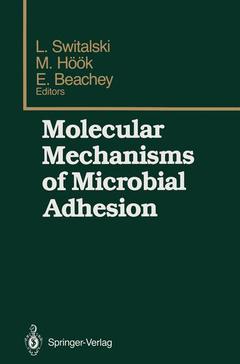Description
Molecular Mechanisms of Microbial Adhesion, Softcover reprint of the original 1st ed. 1989
Proceedings of the Second Gulf Shores Symposium, held at Gulf Shores State Park Resort, May 6–8 1988, sponsored by the Department of Biochemistry, Schools of Medicine and Dentistry, University of Alabama at Birmingham, Birmingham, Alabama
Coordinators: Switalski Lech, Höök Magnus, Beachey Edwin
Language: English
Subjects for Molecular Mechanisms of Microbial Adhesion:
226 p.
· 15.5x23.5 cm
· Paperback
Description
/li>Contents
/li>
It has been 80 years since the subject of bacterial adhesion to surfaces was first brought forth, but only in the last two decades has the importance of this subject been recognized by medical microbiologists. The fact that bacterial attachment to the host tissue is a prerequisite for infection understandably led to the hope that infections could be prevented by blocking the adhesion of pathogenic bacteria. Progress in this field has been so rapid that it has become difficult to keep up with recent developments. This book contains the proceedings of the symposium on the Molecular Mechanisms of Microbial Adhesion, May 6-8, 1988. Both the symposium and this book were intended as an up-to-date review of the most recent findings concerning the adhesion of medically important bacteria. In addition, this book contains critical and provocative overviews of the past, present and future of this field.
Bacterial Adherence.- Heterogeneity of Renal Glycoconjugates: Biochemical and Bacteriological Aspects.- TCP Pilus Expression and Biogenesis by Classical and EL TOR Biotypes of Vibrio Cholerae 0l.- Isolation of the Pre-Assembled Gal ? (1–4)Gal-Specific Pilus-Associated Adhesin from the Periplasm in Uropathogenic Escherichia Coli.- Interaction of Isogenic Pilus+ and Pilus? Variants of Gonococci with a Human Epithelial Cell Line.- Molecular Approaches to Characterization of Mycoplasmal Adhesins.- Current Experience from the Interaction of Bacteria with Glycosphingolipids.- Molecular Basis for Fibronectin-Mediated Adherence in the Syphilis Spirochetes.- A Fibronectin Binding Protein on Staphylococcus Aureus and Bacterial Adherence.- Evolutionary Conservation of the Binding Site of a Laminin Receptor as Determined by Monoclonal Antibodies and Hydropathically Complementary Peptides.- Effect of Mucosal Antibodies to M Protein on Colonization by Group A Streptococci.- Adsorbed Salivary Proline-Rich Proteins as Bacterial Receptors on Apatitic Surfaces.- Bacterial and Host Cell Receptors for the Actinomyces spp. Fimbrial Lectin.- Adhesins of Bacteroides Loescheii.- The Race for the Surface: Microbes, Tissue Cells, and Biomaterials.- Bacterial Adherence as Target for Preventing Infection.
© 2024 LAVOISIER S.A.S.
These books may interest you

Glycoscience and Microbial Adhesion 210.99 €



